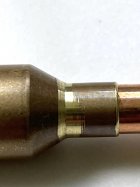The burr on the case mouth. I believe it meant the cases were sitting up on this burr and so with a bullet seated there was interference on the bullet. Since the interference was on the bullet, rather than case, it did not show when chambering the same cases without bullets. Shoulder bump, case neck length etc was all fine. The burr was not. Deburr a case, re-seat a bullet at the same CBTO and everything chambered ok. Frank nailed it.
(When I put the cases back through my neck turning lathe some cases had a small amount of brass trimmed right near the case mouth even after deburring.)
Re the video I posted of my chamber I realized later I hadn't cleaned the rifle after shooting the rounds that day. Duh! I received the JB only today and haven't yet put it to use but, having cleaned the rifle thoroughly and looked again in the borescope I don't see any ring. Perhaps I should post another vid for you guys to check or just give it a go over with JB for good measure but rounds are chambering easily without it.
(When I put the cases back through my neck turning lathe some cases had a small amount of brass trimmed right near the case mouth even after deburring.)
Re the video I posted of my chamber I realized later I hadn't cleaned the rifle after shooting the rounds that day. Duh! I received the JB only today and haven't yet put it to use but, having cleaned the rifle thoroughly and looked again in the borescope I don't see any ring. Perhaps I should post another vid for you guys to check or just give it a go over with JB for good measure but rounds are chambering easily without it.











